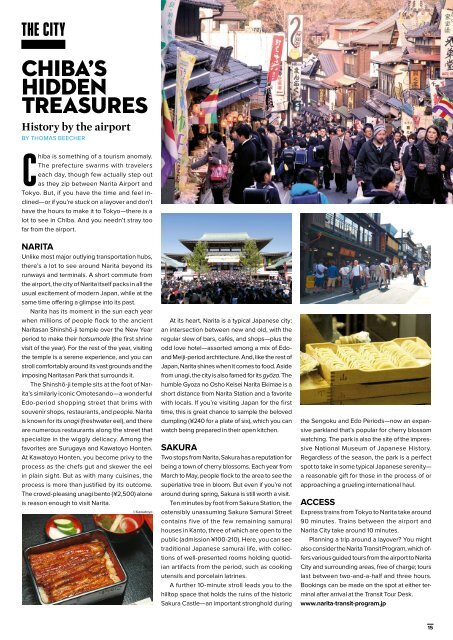DAVID BOWIE
1lVsfhZ
1lVsfhZ
You also want an ePaper? Increase the reach of your titles
YUMPU automatically turns print PDFs into web optimized ePapers that Google loves.
THE CITY<br />
CHIBA’S<br />
HIDDEN<br />
TREASURES<br />
History by the airport<br />
BY THOMAS BEECHER<br />
Chiba is something of a tourism anomaly.<br />
The prefecture swarms with travelers<br />
each day, though few actually step out<br />
as they zip between Narita Airport and<br />
Tokyo. But, if you have the time and feel inclined—or<br />
if you’re stuck on a layover and don’t<br />
have the hours to make it to Tokyo—there is a<br />
lot to see in Chiba. And you needn’t stray too<br />
far from the airport.<br />
NARITA<br />
Unlike most major outlying transportation hubs,<br />
there’s a lot to see around Narita beyond its<br />
runways and terminals. A short commute from<br />
the airport, the city of Narita itself packs in all the<br />
usual excitement of modern Japan, while at the<br />
same time offering a glimpse into its past.<br />
Narita has its moment in the sun each year<br />
when millions of people flock to the ancient<br />
Naritasan Shinshō-ji temple over the New Year<br />
period to make their hatsumode (the first shrine<br />
visit of the year). For the rest of the year, visiting<br />
the temple is a serene experience, and you can<br />
stroll comfortably around its vast grounds and the<br />
imposing Naritasan Park that surrounds it.<br />
The Shinshō-ji temple sits at the foot of Narita’s<br />
similarly iconic Omotesando—a wonderful<br />
Edo-period shopping street that brims with<br />
souvenir shops, restaurants, and people. Narita<br />
is known for its unagi (freshwater eel), and there<br />
are numerous restaurants along the street that<br />
specialize in the wiggly delicacy. Among the<br />
favorites are Surugaya and Kawatoyo Honten.<br />
At Kawatoyo Honten, you become privy to the<br />
process as the chefs gut and skewer the eel<br />
in plain sight. But as with many cuisines, the<br />
process is more than justified by its outcome.<br />
The crowd-pleasing unagi bento (¥2,500) alone<br />
is reason enough to visit Narita.<br />
©Kawatoyo<br />
At its heart, Narita is a typical Japanese city:<br />
an intersection between new and old, with the<br />
regular slew of bars, cafés, and shops—plus the<br />
odd love hotel—assorted among a mix of Edoand<br />
Meiji-period architecture. And, like the rest of<br />
Japan, Narita shines when it comes to food. Aside<br />
from unagi, the city is also famed for its gyōza. The<br />
humble Gyoza no Osho Keisei Narita Ekimae is a<br />
short distance from Narita Station and a favorite<br />
with locals. If you’re visiting Japan for the first<br />
time, this is great chance to sample the beloved<br />
dumpling (¥240 for a plate of six), which you can<br />
watch being prepared in their open kitchen.<br />
SAKURA<br />
Two stops from Narita, Sakura has a reputation for<br />
being a town of cherry blossoms. Each year from<br />
March to May, people flock to the area to see the<br />
superlative tree in bloom. But even if you’re not<br />
around during spring, Sakura is still worth a visit.<br />
Ten minutes by foot from Sakura Station, the<br />
ostensibly unassuming Sakura Samurai Street<br />
contains five of the few remaining samurai<br />
houses in Kanto, three of which are open to the<br />
public (admission ¥100-210). Here, you can see<br />
traditional Japanese samurai life, with collections<br />
of well-presented rooms holding quotidian<br />
artifacts from the period, such as cooking<br />
utensils and porcelain latrines.<br />
A further 10-minute stroll leads you to the<br />
hilltop space that holds the ruins of the historic<br />
Sakura Castle—an important stronghold during<br />
the Sengoku and Edo Periods—now an expansive<br />
parkland that’s popular for cherry blossom<br />
watching. The park is also the site of the impressive<br />
National Museum of Japanese History.<br />
Regardless of the season, the park is a perfect<br />
spot to take in some typical Japanese serenity—<br />
a reasonable gift for those in the process of or<br />
approaching a grueling international haul.<br />
ACCESS<br />
Express trains from Tokyo to Narita take around<br />
90 minutes. Trains between the airport and<br />
Narita City take around 10 minutes.<br />
Planning a trip around a layover? You might<br />
also consider the Narita Transit Program, which offers<br />
various guided tours from the airport to Narita<br />
City and surrounding areas, free of charge; tours<br />
last between two-and-a-half and three hours.<br />
Bookings can be made on the spot at either terminal<br />
after arrival at the Transit Tour Desk.<br />
www.narita-transit-program.jp<br />
15


